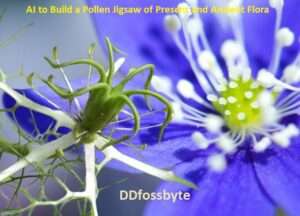In the quest to decode the mysteries of current and ancient plant life, Artificial Intelligence (AI) has emerged as a powerful tool. Through its ability to analyze and organize pollen data, AI is revolutionizing our understanding of flora throughout history.

Here, We explores the groundbreaking work being done to construct a comprehensive pollen jigsaw of both contemporary and ancient plant species.
The Significance of Pollen:
Pollen grains are microscopic, yet they hold a wealth of information about plant life. By examining pollen samples, scientists can determine the types of plants that once thrived in a specific area, shedding light on the Earth’s ecological history. Moreover, understanding pollen is crucial for modern agriculture, as it aids in crop management, allergy research, and ecosystem preservation.
AI’s Role in Pollen Analysis:
AI is reshaping the way we approach pollen analysis. Traditional methods involved painstakingly identifying and categorizing pollen grains under a microscope. However, AI algorithms are now capable of automating this process, making it faster and more accurate. Machine learning models can recognize and classify pollen grains with remarkable precision, enabling researchers to process vast quantities of data efficiently.

The Power of Historical Pollen Data:
One of the most exciting applications of AI in pollen research is the reconstruction of past ecosystems. By analyzing pollen from sediment cores, researchers can piece together a detailed history of plant life in a particular region. This historical perspective is invaluable for understanding environmental changes, such as climate shifts, land use alterations, and species migrations.
Predictive Insights for Future Flora:
AI doesn’t just stop at analyzing historical pollen data; it can also help predict future plant distributions. By combining historical data with climate models and ecological factors, AI can forecast how plant species might respond to changing environmental conditions. This predictive capability is vital for conservation efforts and planning sustainable land use.
Collaborative Efforts:
The advancement of AI in pollen research is a collaborative endeavor involving scientists, botanists, ecologists, and computer scientists. The synergy between these disciplines has paved the way for innovative techniques and tools that continue to expand our knowledge of plant life on Earth.

Furthermore, AI is playing a pivotal role in the quest for efficient and scalable methods to store and utilize renewable energy. It aids in discovering new electrocatalysts that can facilitate the storage and use of renewable energy sources. Additionally, AI is employed to predict renewable energy availability in advance, optimizing energy utilization. This multifaceted investment in AI research, development, and implementation has resulted in exponential growth in AI data, models, and infrastructure capacity.
The collaborative effort between scientists at the University of Exeter and cutting-edge technologies like imaging flow cytometry and AI. This system aims to identify and categorize pollen at an accelerated pace, offering a more complete depiction of historical plant species. Moreover, there is potential for this technology to enhance pollen readings in today’s environment, which could be beneficial for individuals suffering from hayfever.

The system uses imaging flow cytometry to capture images of pollen grains. It then uses deep learning to identify the different types of pollen. This system has already been used to analyze a 5,500-year-old sample of lake sediment.

Here are some of the key benefits of using AI to identify pollen:
- Speed and accuracy: AI can identify pollen grains much faster and more accurately than humans can.
- Scalability: AI can be used to analyze large amounts of pollen data quickly and easily.
- Objectivity: AI is not biased by human factors such as fatigue or experience.

Artificial Intelligence is unraveling the pollen puzzle of present and ancient flora, ushering in a new era of discovery and understanding. By automating pollen analysis, reconstructing historical ecosystems, and predicting future plant distributions, AI is providing invaluable insights into the world of plants. This collaborative effort between technology and science is sure to yield even more exciting revelations in the years to come.
